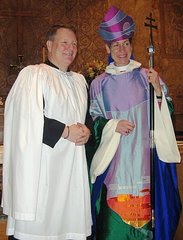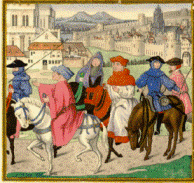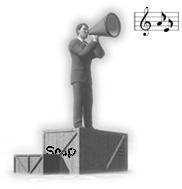 It's a bit naff to do this, but this blog is serving as an online resume for me these days, so here goes...
It's a bit naff to do this, but this blog is serving as an online resume for me these days, so here goes...
I'm proud to let you all know that I've been awarded the Alumni/ae Prize in Ecclesiastical History for 2008. The award was established in 1895 for the graduating student essay on "the historical interpretation of the life and thought of the Church of England with special reference to its continuity with the ancient Catholic church". In this case, 'Church of England' is broadly extended to include The Episcopal Church and the Anglican Communion. We were given a choice of three quotes to base our essay on. The essay had to be written in a two-hour period, and was 'open book'. I'm not saying this essay is my best work, but as the last thing written in my senior year, at the end of exam week, and at the tail end of three tedious but thrilling years of study, it ain't so bad. My essay text is below:
“This is and has been the open profession of the Church of England: to defend and maintain no other Church, faith, and religion than that which that is truly Catholic and Apostolic and for such warranted, not only by the written word of God but by the testimony of the Ancient, Godly Fathers.”
—John Overall, Dean of St. Paul’s Cathedral, London
John Overall was born in 1559, months after Elizabeth I had come to throne and in the year that the Book of Common Prayer was reestablished as the standard of faith for the Church of England. Overall was a translator of the Authorized Version of the Bible under James I & VI. Overall’s defense of the Church of England in this short statement hinges on three assertions of the Church of England’s identity. It is Catholic and Apostolic, it is Biblical, and loyal to the interpretations of the faith of the earliest Church Fathers. This Church of England is then a catholic church in that in addition to the Bible, it follows those catholic principles of fealty to the earliest Christian church which professed a faith believed to be handed down directly from the apostles and formed by the early church fathers.
Overall’s defense is notable for what it omits. It omits the authority of the Pope. It omits the authority of church councils later than Chalecedon, notably the Council of Trent, while including those councils where the creedal statements of the faith were compiled (i.e. the testimony of the Ancient, Godly Fathers). It omits such later philosophies and theologies that may have become accepted by the church such as the work of Thomas Aquinas. Overall’s assertion is that the Church of England is catholic in that it is authentic to the earliest examples of Christianity and to Christian scripture.
The Oxford Dictionary of the Christian Church gives this definition of the term catholic as meaning, “In general, in present-day usage, it is employed of those Christians who claim to be in possession of a historical and continuous tradition of faith and practice, as opposed to Protestants, who tend to find their ultimate standards in the Bible as interpreted on the principles of the Reformation of the 16th century” (305-6). We see in Overall’s statement that not only is he omitting certain ideas about catholicity that would have been claimed by the Roman church, he is also including certain attributes that would have been condemned by the more radical reformers of the 16th century. Overall asserts that the apostolic faith as interpreted by the church fathers is essential to the Church of England. These church fathers and their writings were supercilious to the more radical, Protestant reformers who sought to make scripture alone the standard of Christian religion. For Overall, the Bible is indeed a standard of the faith, but in conjunction with the received apostolic tradition, and the earliest interpretations from the church fathers. It’s worth noting that in including the Bible in his statement Overall uses it in a negative locution: “not only by the written word of God” (emphasis added). Overall deemphasizes the Bible in favor of apostolic tradition, and early church interpretation; a stance somewhat surprising for one of the English Bible’s translators.
In her volume on the early church in The New Church’s Teaching Series, Rebecca Lyman describes the emphases of the English Reformation. “In their search for a catholic and reformed church independent of Rome at the Reformation, Anglicans went back not only to scripture, but to these earliest centuries of the church. Here the reformers found a model for liturgy in the language of the people, a learned and pastoral theology, and the shared authority of the councils” (3). Lyman sees in the newly independent Church of England a clear desire to emulate those earliest Christians from the era when the church was truly catholic and apostolic. Lyman describes the ‘apostolic tradition’ as “the teachings of Jesus that were preached through the earliest missionaries or apostles” (5). She goes on to describe what apostolic and catholic meant in the early church era. “Early Christians used the terms ‘apostolic’ and ‘catholic’ to refer to this core inheritance of the first communities. They defined as authentic and therefore ‘apostolic’ those inherited teachings that could be tested by universal (‘catholic’) and public testimony” (5).
Overall’s immediate ecclesiastical predecessors working in the reigns of Henry VIII, Edward VI and Elizabeth I would have relied heavily on Renaissance humanist scholarship that revered the earliest manuscripts then available. “Those responsible for shaping the Reformation in England… enthusiastically built upon one of the great gifts of the Renaissance, a high regard for the past” (Thompsett 6). Humanist reinterpretation of ancient manuscripts led to new understandings of the earliest Christian communities and their practices. As John Booty writes in his introduction to An Apology of the Church of England by John Jewel, the English reformers saw “humanist studies breaking through the arid and corrupt accumulations of the recent past, providing… the opportunity and the means for probing into the period of the primitive church” (xviii). The English Reformation took advantage of new thought and new learning in order to reach beyond the accretions of medievalism to find a more authentic catholicism in the earliest apostolic church. And it was to this model that they sought to adhere.
“(T)he recovery of ancient Christianity through the work of educated men such as Archbishop Thomas Cranmer significantly affected the polity, spirituality, and worship of the English church in the 16th century. Like others of their day, these reforming scholars saw the ancient church as an authority to cleanse and correct the contemporary church, as well as to deflect Roman Catholicism’s exclusive claims to antiquity and truth” (Lyman 8). Catholicity as understood by Overall and the English reformers was a concept inextricably tied to the early church, and not to the See of Rome. Scholarship had shown a church that was more counciliar, more pure, less corrupted by centralized power, with a great regard for the scriptures. This early church was understood as catholic and it is this catholicity that the Church of England sought to emulate at the Reformation. “In essence, our illustrious Reformation ancestors backed up one thousand years to the traditions of their forebears” (Thompsett 7) in order to find a true religion with which to reform the Church of England. Simply put, the Church of England believed itself to be “offering a more authentic Catholicism than that offered by the Church of Rome” (MacCulloch 493).
The regard for the historically catholic can be found in later eras of Anglicanism. “(T)he ancient church had its most powerful effect on Anglicanism… in the Oxford Movement” (Lyman 11). In an attempt to revitalize the worship and theology of the Church of England, Newman, Pusey, Keble, J. M. Neale and others associated with the Oxford and Cambridge movements sought to revive ancient catholic ecclesiology and ritual. Initially theological, the Oxford Movement was specifically and unashamedly catholic, and sought to move the Church of England away from its more Protestant understanding of polity initially, and later toward more ancient, catholic forms of worship. Anglicanism became more and more ‘Anglo-Catholic’ as a result of the Oxford Movement and the work of the ritualists associated with the movement. These efforts gave Anglicanism back an aesthetical catholicity that once again did not require adherence to Roman authority.
Later efforts to reconcile elements in the Church of England that were struggling with modernism resulted in Anglican bishop and scholar Charles Gore’s Lux Mundi. Gore looked to the Reformation to find a model of reform that valued catholicity while allowing for change. He wrote, “It is the glory of the Anglican Church that at the Reformation she repudiated neither the ancient structure of catholicism nor the new and freer movement” (Lyman 12) toward reform. Gore saw value in maintaining catholicity as essential to Anglicanism as it reformed itself, and proposed that such a model should be followed as Anglicanism struggled to encompass modernity.
As various streams of Christianity sought to move closer together in the United States and in England, the catholic identity of the church was again affirmed in the Chicago-Lambeth Quadrilateral. In ecumenical endeavors, Anglicanism would maintain sacramentality, creedal theology as derived from the early church councils, Biblical authority, and episcopal governance descended from the ancient church and the apostles themselves. A catholic Anglicanism would continue in the apostolic tradition, with the orders of ministry as described by the church fathers, and with the earliest church’s understanding of sacredness in the two sacraments of baptism and the Eucharist.
As Anglicanism grew and comprised more independent provinces, its essential catholicity was maintained. In describing the Anglican Communion in the 2oth century, Archbishop William Temple wrote, “(Anglicanism is) solidly catholic, as in its doctrine, so also in its affirmation of continuity in time and unity through space, expressed by outward obwervances” (Schmidt 259). Also in the 20th century, regard for early church practice is again seen in the liturgical movement's renewal of worship. “Studies of ancient liturgy also underlay the Liturgical Renewal movement of the 20th century which sought to restore many of the theological and liturgical understandings of prayer and the sacraments from the early church” (Lyman 13). Again Anglicanism seeks to reform itself along catholic lines to maintain its attachment to the practice and theology of the earliest Christian church -- when the undivided church could truly be called catholic and apostolic.
“At the end of (the 20th) century… we may be closer to the intentions of our earliest Christian ancestors than we were at the start” (Thompsett 12). Anglicanism retains its catholic identity today, in its worship, in its creedal theology, in its governance and polity. We continue to maintain the catholicism that was seen in the earliest, undivided Christian church. We continue to define a core catholicity as essential to the church’s identity. Overall’s statement could be made today as easily as it was in the immediate wake of the 16th century reformation of Anglicanism. We were then and continue to be ‘Catholic and Apostolic.’
Booty, J. E. An Apology for the Church of England by John Jewel. New York: Church Publishing. 2002.
Cross, F.L. and E.A. Livingston, eds. The Oxford Dictionary of the Christian Church. 3rd ed. New York: OUP, 1997.
Lyman, Rebecca. Early Christian Traditions. The New Church’s Teaching Ser. 6. Cambridge, MA: Cowley, 1999.
MacCulloch, Diarmaid. The Reformation: A History. New York: Viking. 2003.
Schmidt, Richard H. Glorious Companions: Five centuries of Anglican spirituality. Grand Rapids, MI: Eerdmans, 2002.
Thompsett, Fredrica Harris. Living With History. The New Church’s Teaching Ser. 5. Cambridge, MA: Cowley, 1999.







No comments:
Post a Comment